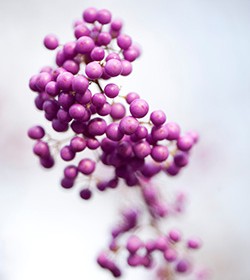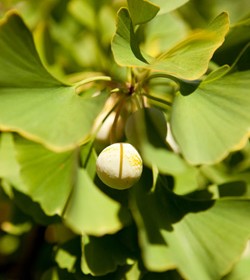Fruiting Frame of Mind
Posted in Horticulture on October 16 2014, by Jaime Morin
Jaime Morin is The New York Botanical Garden’s Assistant Curator in horticulture. She works with the plant records and curation teams to help keep the garden’s information on its living collections up to date. She also oversees the details of the garden’s Living Collections Phenology Project.

Autumn is by far my favorite season. I know it doesn’t bring that sigh of relief the first warm day of spring seems to evoke, nor does it allow for long days at the beach or lake. Yet, what it lacks in promised warmth it makes up for in color. As a native New Englander I was brought up with a strong appreciation for bright fall foliage and the joys of falling into a freshly raked pile of leaves. What I didn’t begin to appreciate until I started really looking at plants in my professional life were the bright colors and interesting forms of fruit and seeds that autumn delivers to us. I don’t mean tasty fall favorites like the apple, but the smaller seed carriers that are often missed if you’re not looking for them.
Take a couple of my favorite colorful fruiting shrubs, beautyberry (Callicarpa spp.) and winterberry holly (Ilex verticillata), as examples. Callicarpa have attractive arching branches with demure flowers in early summer, but they shine brightest in fall when dense clusters of vibrant purple fruit cling along the stems creating the late season echo to the pink redbud flowers from spring. Similarly, Ilex verticillata isn’t your typical wall of evergreen holly foliage. By late October this shrub has dropped its foliage and the females are covered with fruit in fiery hues like orange or red.
What about fruits with interesting form? I love strolling through the Native Plant Garden, Azalea Garden, and Thain Family Forest in the fall to check out all of the different aster seed heads. This group of herbaceous perennials sets beautiful, dense clusters of fluffy seed heads that create plumes of delicate texture. They also seem to have a knack for catching the afternoon sunlight just right. If pretty and delicate isn’t your thing, look out for the sweetgum’s (Liquidambar styraciflua) one-inch “gumballs.” These mace-shaped fruit hang from their trees until late fall, when they drop to the ground. To me these cool, spiny seed bearers look like a medieval weapon ready to strike. If you’ve ever stepped on one in bare feet they feel like that, too!
I must gently remind our enthusiastic readers that no matter how beautiful or delicious-looking a fruit may be, plucking things from our plants here at the garden should be avoided. Many of our gardeners and curators need to collect these seeds to further develop the garden’s collections. In fact, one of my favorite horticultural tasks involves collecting seeds for curators here and at other botanical institutions. To me the act of preserving species diversity and sharing wonderful plants with colleagues brings a feeling of purpose and excitement to an already festive season! We aren’t the only ones that try to track down these seeds, though. Migratory birds and small woodland animals preparing for winter also collect fruits and seeds to help them prepare for the harsh winter months ahead.

Another beautiful fall feature (but too often dismissed as undesirable to many) are the seeds of Ginkgo biloba, or maidenhair tree. Female specimens of these iconic street trees produce smooth, round seeds with a fleshy red covering that are very pretty and have been cultivated for human consumption for centuries. Their one shortcoming in a garden, park, or campus setting is the putrid smell that they give off after they have dropped and sat on the pavement for a day or two. Because of this, many landscape designs call for male trees specifically. These plants often don’t reach sexual maturity until 20 years old so every once in a while you may get one that surprises you. My Nana always said “leave the world a little sillier than you found it,” and I truly believe that we can ascribe that same philosophy to unique plants as well. Despite their rank smell these fall seeds are too interesting to shy away from!
Of course I would be remiss to gloss over some of our interesting yet lesser known edible fruits. Kousa dogwoods (Cornus kousa) develop deep red wrecking ball-shaped orbs that hang from the trees. Their thick skinned fruits have soft orange flesh that is delightfully sweet albeit a little bit mealy in texture. Our native chokeberries also produce a delectable fall offering. Their tart black or red fruits pack an incredible punch of nutrients and antioxidants. Finally if you are a connoisseur of tart treats, the American cranberrybush (Viburnum opulus var. americanum) offers bright red treats that you won’t have to race the birds to. Our current first year class of SOPH students chuckled this past week as they watched me bite into one and cringe at its still-too-tart astringency.
Please remember, though, to be wary of what plants you choose to eat from. You should never forage unfamiliar plants without the help of a professional. As city dwellers and suburbanites, we are instilled with a justified fear of unknown fruits. In fact one of my neighbors in my apartment complex gapes at me in horror as I harvest serviceberries from the tree in front of our building every summer. Each year I ask him if he would like some of the sweet bounty just to garner a response of “You’re going to poison yourself with those things and I don’t want you taking me down with you.” It’s an annual ritual between him and me that makes me happy for two reasons; it leaves more delicious treats for me and he is not risking his health because a random, petite girl in flannel says it’s alright.
Next time you go out for a crisp fall stroll remember to look beyond the flashy foliage to discover a whole world of shapes, textures, and colors in fruit. There is incredible diversity out there just waiting to be noticed and appreciated!


Great post Jaime. I had no idea that Cornus fruit was edible.
Here in Australia we call those liquidambar fruit ‘bommy knockers’. I’ve often wondered why ‘serviceberries’ are so called?